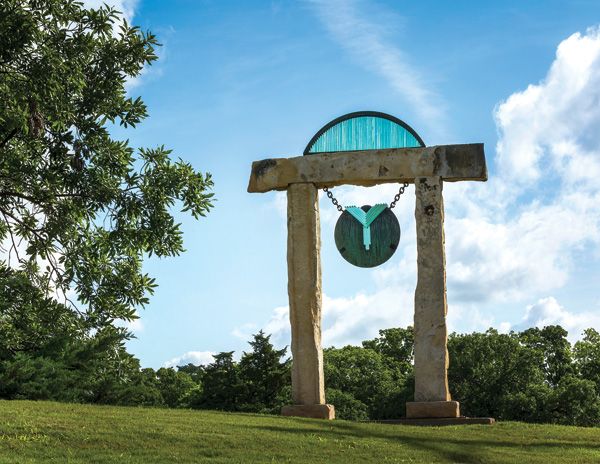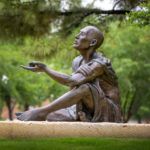A small Oklahoma town finds community through public art
By Bonnie Gangelhoff

Flor de la Vida, limestone, glass, bronze, steel, & marble piece by Greg Reiche, north side of 2nd St at entry of Sugar Hill Ranch, between Douglas & Post Road
This story was featured in the October 2017 issue of Southwest Art magazine. Get the Southwest Art October 2017 print issue or digital download now–then subscribe to Southwest Art and never miss another story.
Every city, whether large or small, has its tales to tell. And for art lovers everywhere, the tale of Edmond, OK, is one worth knowing. Perched in the heartland of America just north of Oklahoma City, the community of 90,000 people boasts nearly 200 public artworks on display throughout the town. Most of them are sculptures, and they can be found in front of banks, libraries, churches, hospitals, law firms, elementary schools, restaurants, and real-estate agencies. They range in style from Kevin Robb’s abstract, stainless-steel DANCING TRIANGLES to Mark Hopkins’ FISHING HOLE, a realistic bronze depicting a young boy perched on a downed tree fishing with a tree-branch “fishing pole.” There are dozens more pieces by other prominent sculptors, such as Tim Cherry, Gerald Balciar, Glenna Goodacre, and Shirley Thomson-Smith.
Some pieces tell stories of triumph, such as Shan Gray’s bronze honoring hometown hero Shannon Miller, a gymnast who won seven Olympic medals. Other pieces speak of tragedy: Rosalind Cook’s STORY TIME FOR THREE was installed at Edmond North High School in memory of a 17-year-old student who died in an automobile accident.
And some artworks are just for fun: If you happen to stop in for breakfast at Around the Corner, a restaurant onSouth Broadway, HAM & EGGS by Diane Mason greets you at the front door. The bronze pig with a chicken on its back seems an appropriate homage to the creatures that make many popular dishes at the café possible. If you need to fuel the car instead, load up the kids and drive over to the OnCue convenience store on South Kelly Street to see Joshua Tobey’s joyful bronze bear BELLY DANCER welcoming customers to the pumps. This store and its sister location nearby may be the only places in America where one can buy a doughnut and some diesel and see sculptures by nationally known artists in the same place.
- Ancient One, a bronze by Gino Miles, north side of 2nd St at entry of Sugar Hill Ranch, between Douglas & Post Road
- Fishing Hole, a bronze by Mark Hopkins, SW corner of 15th & Kelly 6
- Ham ’N Eggs by Diane Mason.
In short, Edmond is a small town with a huge heart for art—a place that brings art to the people.
Since the year 2000, the city of Edmond has allocated at least $100,000 per fiscal year toward the purchase of public art. For each installation the city agrees to pitch in a maximum of $30,000, and then private citizens or groups are responsible for matching the other half. In the case of STORY TIME FOR THREE, the parents who lost their teenage daughter chose the work and wrote a check for half the cost. The city did the rest.
In the case of HAM & EGGS, the origi-nal owner of the café wanted desperately to purchase the piece, but she didn’t have the funds to match the city’s contribution. Undaunted, she took a photograph of HAM & EGGS, displayed it next to a jar, and asked customers for donations. Within a few months she had collected the funds needed.
In yet another example of partnership, a group of employees at Edmond’s financial services department approached Randel Shadid—an initial catalyst for the public-art program—and asked why the government building they worked in seemed to be the only one without public art. Shadid explained, “Because you didn’t write a check for your half.”
The employees sprang into action and raised their half of the cost for a sculpture they wanted titled HUMPTY DUMPTY by Kimber Fiebiger. Everyone seems to enjoy the piece, but as Shadid points out, a few of the City Council members thought a depiction of Humpty Dumpty was inappropriate for a government building. “That seemed amusing to me in that people who come to this building are often unhappy about having to pay their utility bills or reconnecting their service after a shutoff,” he says. “It seemed logical to have a happy piece in front of the building to calm the nerves of those who were distressed when they arrived. HUMPTY DUMPTY puts a smile on their faces.”
- Humpty Dumpty by Kimber Fiebiger.
- Touch the Clouds, a bronze by Dave McGary, UCO, west of Garland Godfrey entrance on 2nd 1
- Truth Seeker, a bronze patina by Gregory Reade, NE corner of Campbell & Boulevard 1
Meanwhile, when residents step inside the building to pay their bills, they may be in such good spirts they would consider contributing to the public-art program. Payment windows feature a mini HUMPTY DUMPTY to remind residents that, with their utility-bill payments, they can make regular monthly contributions for the purchase of public art. HUMPTY DUMPTY is now a city landmark of sorts and one of the most photographed sculptures in town.
Incidentally, a city ordinance now requires every new government building project to set aside 1 percent of the construction costs for public art. In 2015, when the city built a new multimillion-dollar public-safety center for its police department and crime lab, the funds purchased Jane DeDecker’s bronze titled SHERLOCK HOLMES for the lobby—an appropriate spot for fiction’s most famous and beloved detective.
Edmond’s public-art program is administered by the Edmond Visual Arts Commission, which was established in 2001. The commission meets once a month to review applications for matching funds. On the commission’s web page, interested residents can access a one-page application, along with a description of the program’s policies and procedures. There’s also a list of the artworks in the collection and an interactive map.
But how did a city of 90,000 people become a mecca for public art with an annual budget of just $100,000? Before the commission was established in 2001, there was Randel Shadid, an attorney, a knowledgeable art collector, and a former Edmond mayor. Shadid and his wife, Dana, own a 650-piece, museum-quality art collection that fills the walls of their home. In 2000, when Shadid was the chairman of the Central Edmond Urban Development Board, he learned that there was an unexpected surplus in the budget at the end of the fiscal year. At the next board meeting, he placed an item on the agenda with a formal request for action to purchase five sculptures for the city, at a cost of $100,000 from the budget surplus. At Shadid’s urging, both the board and the City Council approved the action, purchasing works by Gary Alsum, Marianne Caroselli, David Pearson, Rosie Sandifer, and Gary Lee Price. “It was a deal,” Shadid says. “The $100,000 was the total price for the five pieces. That was before the cost of bronze skyrocketed. We installed all of the pieces in the downtown area—a critical mass to make a statement.”
- Sacagawea, a bronze by Glenna Goodacre, entrance to Mitch Park, 2733 Marilyn Williams Drive
- Red Sails, a red powder coated steel piece by Jim Stewart, on Kelly north of Covell in median
- Dancing Triangles, a stainless steel piece by Kevin Robb, entry to Fox Lake Plaza, median on 2nd near I-35
In the years that followed that initial purchase, Shadid joined forces with the city attorney to write the first legal document establishing the arts commission and its matching-funds requirement. Today, if you ask Shadid what it takes to launch such a program, he has a quick answer: “You have to have a squeaky wheel,” he offers. “That squeaky wheel was me.” Elizabeth Waner, City Council member and liaison to the commission, adds, “Randel knows no fear.”
Today Shadid describes his role as an advocate for public art. He shows applicants works that might interest them and helps them with the application process. He also keeps files on more than 400 sculptors. For years he has attended Sculpture in the Park, the largest outdoor juried sculpture show in the country, which is held every August in Loveland, CO. He guesses that many of the sculptors in Edmond’s collection have shown at the annual event.
In addition to arts-commission funds, there are other ways the city acquires art. According to Waner, when several Edmond residents learned that the Houston Livestock Show and Rodeo was selling Dave McGary’s monumental sculpture TOUCH THE CLOUDS, they approached the Council with a petition to use the special-projects budget for the purchase. In 2014, the Council agreed and allocated $50,000 to buy it. Additional funds were approved to move the 18-foot-tall, 20,000-pound piece from its home at the Houston Astrodome to Edmond. Private citizens then kicked in $30,000 to refurbish it, which involved cleaning and restoring the original patina. Today, the show-stopping sculpture sits on the campus of the University of Central Oklahoma. And although Chief Touch the Clouds (perhaps named because he stood nearly 7 feet tall) was not from Oklahoma, the piece nonetheless honors the state’s history and connections to Native American cultures.
- Paper Airplane also known as Journeys of the Imagination, a bronze by Gary Lee Price, 2 S. Broadway
- Wheel of Time, a stainless steel and dichroic glass piece by Jeff Laing, 1400 W. Covell Rd in the south flower bed of the Dental building
- Double Dipper, a bronze by Mark Lundeen, located at Bradford Village Retirement Community, 906 N. Boulevard
Finally, to cities thinking about implementing a public-art program of their own, both Shadid and Waner issue a warning: “Expect some pushback from citizens who think filling potholes would be a better investment than art,” Waner says. “But many [of them] turn into its biggest fans. In my opinion, a $100,000-a-year investment for public art in a $275 million budget is a small price to pay to keep the city vibrant.”
Today Edmond’s public-art collection is valued at more than $4 million, according to Waner. “A great return on our investment,” she says. But she points out that the collection’s value is about much more than its monetary worth. For the city, it’s a valuable tool for the encouragement of economic growth, a lure to companies who may see public art as an asset, a quality-of-life benefit for their employees.
But mostly the art is for the folks who call Edmond home, Shadid and Waner say. In Shadid’s words, “Art makes your community more inviting and adds to the civility of the city. It’s hard to be angry when you see a beautiful or whimsical piece of art. Even a piece that is tranquil has an effect, achieving a high degree of civility for residents.”
- The Reader, a life-size bronze by Mary Lou Gresham, Edmond Public Library 10 S. Boulevard
- Story Time for Three by Rosalind Cook.
- Flor de la Vida, limestone, glass, bronze, steel, & marble piece by Greg Reiche, north side of 2nd St at entry of Sugar Hill Ranch, between Douglas & Post Road
This story was featured in the October 2017 issue of Southwest Art magazine. Get the Southwest Art October 2017 print issue or digital download now–then subscribe to Southwest Art and never miss another story.
MORE RESOURCES FOR ART COLLECTORS & ENTHUSIASTS
• Subscribe to Southwest Art magazine
• Learn how to paint & how to draw with downloads, books, videos & more from North Light Shop
• Sign up for your Southwest Art email newsletter & download a FREE ebook




















